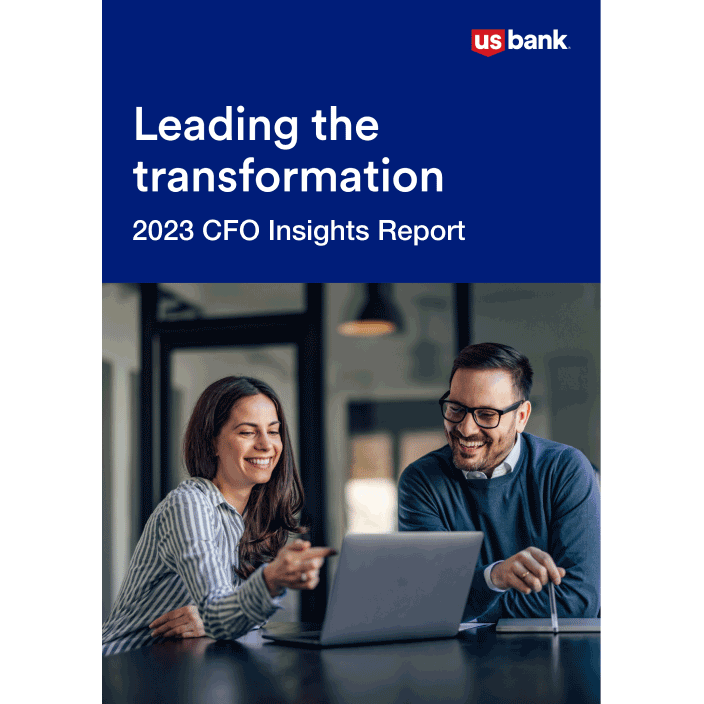Economic data suggests improvement
Shock after shock has pummeled the U.S. economy in recent years. COVID-19 lockdowns brought large parts of the economy to a juddering halt, both in the U.S. and around the world, and threw supply chains into chaos. As the country got back to normal, businesses were hit by rising costs as inflation soared thanks to pent-up domestic demand and Russia’s invasion of Ukraine. The response by the Federal Reserve – 10 consecutive interest rate rises – has created its own challenges.
So it’s no surprise that a May and June 2023 U.S. Bank survey of 1,420 U.S. finance leaders finds them wary about the ongoing threat posed by inflation and elevated interest rates.
Yet the latest economic news and data suggest that the outlook could be improving, and the most acute periods of disruption caused by recent shocks is behind us. How do finance leaders think fast-changing economic risk factors and circumstances will affect their companies in the months ahead?
More Resources
Finance leaders are alert to today’s economic risks.
Our survey shows that finance leaders are highly aware of how recent macroeconomic trends affect their businesses – and they are wary that the impact could increase. They rank high inflation, for instance, as a top-three risk for the second year running: 38% of finance leaders identify it as a risk to their business, up from 34% last year. Rising interest rates, meanwhile, are seen as a risk by 23%, up from 17% last year.
Almost half of finance leaders (49%) say that rising interest rates and the end of the era of cheap money challenge the sustainability of their current finance models. On that basis, they would be well advised to keep their financing under review, particularly since Fed chair Jerome Powell has indicated that further rate rises are likely. “Looking ahead, nearly all committee participants view it as likely that some further rate increases will be appropriate this year to bring inflation down to 2% over time,” said Powell in June.
Powell’s words should be taken seriously: over the past year, inflation has been harder to control through interest rate rises than many economists expected. “The Fed’s indication that there could be two further rate rises in 2023 surprised the markets, but the Fed wants to avoid inflation becoming ingrained into expectations”, explains Matt Schoeppner, senior economist at U.S. Bank. “They’ll err on the side of doing too much if that’s what it takes to bring inflation down.”
But the Fed’s June decision to pause its rate rises reflects the fact that inflation has been falling. As measured by the consumer price index (CPI), inflation halved from its June 2022 peak of more than 9% to 4% year-over-year in May 2023. The biggest concern is that underlying core inflation is proving sticky: it has changed little since last fall, and stood at 5.3% for the 12 months to May 2023. But even this can be seen in a positive light: it was the lowest level since November 2021. So although interest rates are expected to rise again, it may be that we have turned a corner and inflation mitigation measures have helped move us decisively, if gradually, back toward the Fed’s 2% target.
49% of finance leaders feel rising interest rates and the end of cheap money challenge their current models.
“Businesses have generally been successful in maintaining margins, but now, with borrowing costs rising, many businesses feel they can’t pass further price increases on to customers."
Matt Schoeppner
Senior Economist, U.S. Bank
It’s time to cut costs—but which ones?
Nevertheless, businesses are still feeling the impact of increased operating costs. Cutting costs is at the top of finance leaders’ agendas for the next 12 months, because it’s now the main way for firms to protect their profitability. “Businesses have generally been successful in maintaining margins, but now, with borrowing costs rising, many businesses feel they can’t pass further price increases on to customers”, says Matt Schoeppner.
Reducing costs inevitably means confronting tough decisions – including job cuts. Strikingly, however, only 19% of the finance leaders we surveyed say that reducing headcount is on the agenda, which is down from 22% a year ago and 40% in 2021. In economists’ terms, this is known as labor hoarding. But while economic theory might suggest that employers would be starting to cut jobs, the reality is that businesses have faced an intense battle to attract and retain talent during the Great Resignation. Now, they’re reluctant to shed jobs in a knee-jerk response to what they hope will be temporary cost pressures, because they can see themselves back in a fresh fight for talent within months. They don’t want to have to restart the expensive, time-consuming process of recruiting and training new people.
This could have complex economic effects. A tight labor market gives workers a strong hand in salary negotiations, which may add to inflation. On the flip side, low unemployment should reinforce confidence about the economy’s resilience: strong consumer spending could keep the U.S. economy out of recession.
There are reasons to be cheerful.
Consumer demand and slowing inflation rates are not the only reasons to be optimistic about the economic outlook. There’s also been a reduction in political instability.
The invasion of Ukraine sparked sudden increases in food and energy costs during 2022, creating a great deal of uncertainty, but most countries have now adjusted – including in Europe, where people have been most concerned about energy supplies. Elsewhere, geopolitical tensions between the U.S. and China seem to have stabilized, for now. And domestically, the risk of a damaging government default was averted at the start of June when the U.S. Congress passed the Fiscal Responsibility Act.
Despite this, only 36% of the finance leaders we surveyed say they believe macroeconomic risks such as high inflation and recession are receding. But this attitude is at odds with recent economic data: many analysts have had to push back their forecasts for when recession might hit, and U.S. Bank’s own assessment is that the odds of recession now stand at about 50%. If it does happen, it would most likely be the result of falling business investment, because unemployment remains low – although the odds increase if employers do start to shed jobs. Even then, we expect any recession to be mild.
There’s an alternative scenario. What if inflation continues to come down meaningfully while the fundamentals, including consumer demand, remain healthy? That could make the picture in mid-2024 similar to today’s, with modest growth of about 1.5%. “This would represent the sort of ‘soft landing’ or ‘controlled landing’ that the Fed is hoping for”, says Matt Schoeppner.
It’s understandable that finance leaders are wary of the ongoing impact of inflation, rising interest rates and the risk of recession. But they should also recognize that there are some increasingly positive indicators, and that a few important causes of uncertainty have now stabilized. If it turns out that inflation is now on a sustainable downward trajectory, the U.S. economy could take us by surprise.
Read more from our research.

HEALTHCARE INSIGHTS
Healthcare finance leaders seek cost savings.

PAYMENTS INSIGHTS
Instant payments adoption surges.

CALIFORNIA REPORT
143 California finance leaders share their views.

DIGITAL TRANSFORMATION
4 steps for a successful digital transformation

Finance leaders voice their views in our 2023 CFO Insights Survey.
More than 1,400 finance leaders from companies across industries and across the nation told us what they’re focused on as they manage their businesses in today’s dynamic environment. From controlling costs to sourcing talent to embracing digital tools, survey respondents are juggling multiple priorities. Use their insights to inform your own leadership approach.

